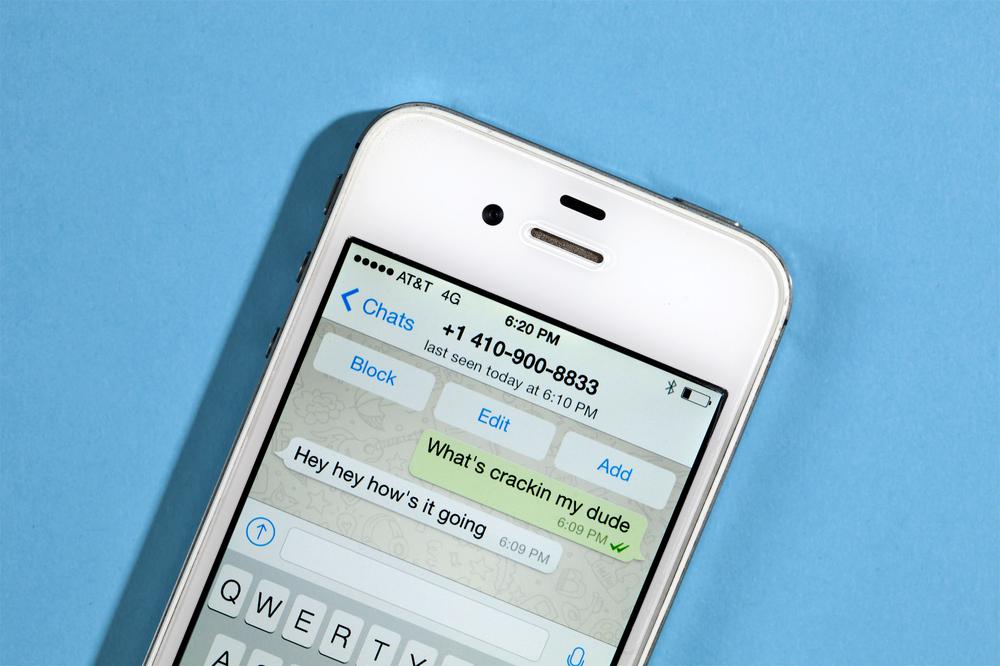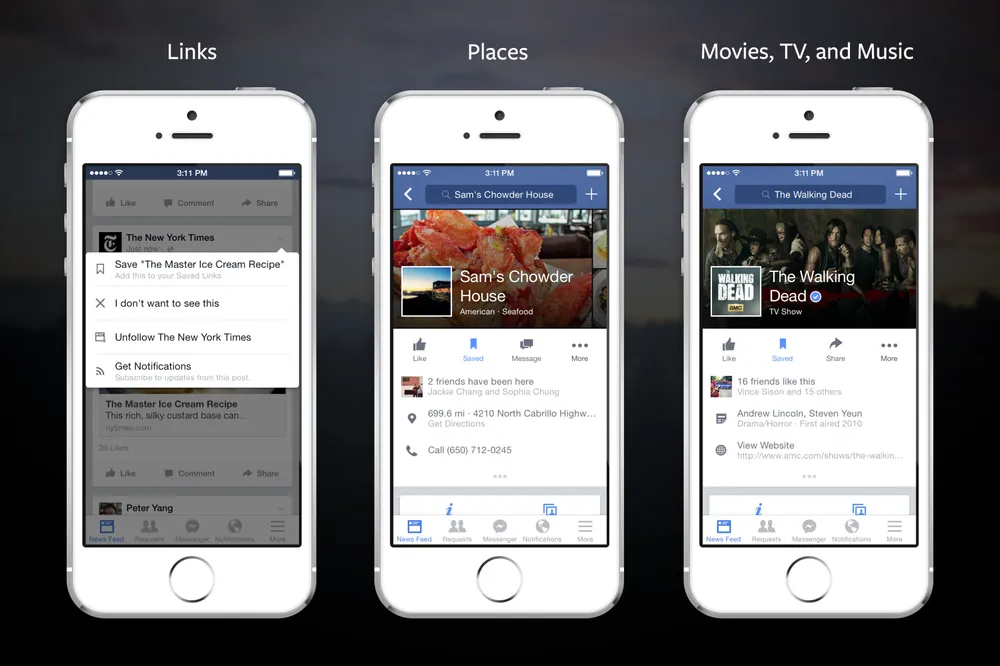Facebook forever

Until as recently as last year, Mark Zuckerberg thought of Facebook as a web company. Now, he says, mobile is the company’s “big focus” moving forward. In this series, we’ll examine Facebook’s strategic positioning to become a conglomeration of great mobile experiences, offer a wealth of features to displace competitors, and build a next-generation mobile platform designed to replace the web.
- Assimilating every great mobile experience
- Growing mobile features to include everything
- A wearable platform to replace the web
Assimilating every great mobile experience
In 2008, Facebook released the first version of their iOS app to coincide with the launch of the App Store. The app’s interface was built to match the glossy buttons of iOS (then called iPhone OS) 2.0, but featured clunky web views of the News Feed and spotty performance issues as a result. Facebook has reinvented their flagship app some half-dozen times in the years since then, but recently the company has begun concentrating their efforts on a new mobile strategy: conglomeration.
While Facebook’s unmatched army of users may love their web interface and mobile apps today, the company isn’t banking on their loyalty forever. To ensure its survival for the next decade, Facebook has begun making strategic acquisitions that will position the company for long-term usership and relevance — if not as Facebook the product, then as Facebook the company.
Facebook the product may not last forever. But Facebook the company just might.
Some of these additions have seemed likely to conflict with Facebook’s existing offerings, but that may be exactly the idea. In 2012, Facebook acquired budding photo sharing network Instagram for $1 billion, a deal that was questioned by pundits but seems like a bargain in hindsight. Some of the confusion stemmed from the fact that Facebook already offered a Photos product, which included comments and likes much like Instagram’s. They had even developed a Camera app that featured filters and effects matching many of those found in Instagram. Their existing services even included tagging and geolocations, two features that didn’t come to Instagram until later.
But the overlap didn’t matter. Rather than investing in its existing products in order to compete, Facebook chose to control another mobile experience that engaged users in new ways. And with new development and infrastructure resources from Facebook at their disposal, Instagram has grown into a mobile giant with 200 million active users. By diversifying their app offerings and building a brand that included neither the words “face” nor “book,” the company grew a new audience of users who may never have an interest in Facebook’s flagship app.
Facebook has since used Instagram as the proving ground for a few new photo messaging initiatives. Since the rise in Snapchat’s popularity and the failure of the company’s Poke competitor, Facebook has used Instagram as the outlet for two new services, Instagram Direct and their recently-leaked Bolt. These messengers hope to leverage Instagram’s incredible popularity to deliver Facebook the Snapchat rival they apparently crave, and feature no explicit relationship to Facebook itself. In theory, future users of Instagram’s Bolt might have no idea that the mobile experience was developed by the same company responsible for Poke and Slingshot — and that’s precisely how Facebook wants it.

A more significant example is Facebook’s highly publicized purchase of WhatsApp for $19 billion in 2013. Facebook purchased the mobile messaging service despite its complete feature overlap with Messenger, and has continued to operate the app and community separate from the rest of Facebook. While it’s conceivably possible that Facebook could have merged WhatsApp with Messenger, growing its user base by more than 200 million, the company seems contented with allowing the service to carry on unaltered. This is perhaps because WhatsApp is targeted at a different market than Messenger, with clients available for platforms like BlackBerry and Symbian, and attracts international interest for its affordability versus traditional SMS messaging.
Interestingly, Facebook has maintained the brand identity of its major acquisitions to date, unlike rivals like Google who appear keen to streamline their offerings with the Google name and suffixal logo treatment. Each of these acquired products services a distinct audience and addresses a unique need, meaning that they can exist in parallel with other Facebook apps on many consumers’ phones. This is at the heart of Facebook’s mobile strategy: it doesn’t matter how you choose to do what you do with your smartphone, as long as you’re using a Facebook property to do it. Or, more specifically, as long as the advertisements you see along the way are being delivered by Facebook.
It doesn’t matter how you choose to do what you do with your smartphone, as long as you’re using a Facebook property to do it.
As recent releases show, Facebook is interested in offering users multiple ways to engage with content on Facebook. News Feed client Paper allows iPhone users to read and share content through Facebook, but secondary features like Events, Groups, and even Timelines take a back seat. New business and brand-focused apps like Pages Manager and Mentions allow companies and marketers to leverage the Facebook platform to engage with users, but leave behind superfluous features targeted at average users.
These remixed versions of the full Facebook experience underscore the company’s commitment to allow mobile users to engage with the Facebook ecosystem in the way that makes sense for them. This extends the relevance and usefulness of content on Facebook and provides for selective participation, meaning users can engage with only those Facebook products they need. Someone can use Messenger and Instagram but never touch the flagship app, another can manage their business’s Page and chat on WhatsApp without ever interacting with Facebook friends. These choices guarantee that Facebook users will continue to have use for Facebook products when they’re uninterested in updating their status — even if that means they leave the little blue “F” off their home screen.
Facebook wants to have as large of a presence on your smartphone’s home screen as they possibly can, no matter who you are or what your interests may be. To that end, they’ve invested billions of dollars and the immense weight of the company’s mobile development resources to develop differentiated mobile experiences that, while they might not advertise the fact, are controlled by Facebook. Next, we’ll investigate how Facebook aims to grow their apps’ feature sets to address as many mobile use cases as possible — and replace any rival apps in the process.

Growing mobile features to include everything
Like many mobile giants, Facebook wants to be an integral part of as many of your mobile experiences as possible. They’re looking to increase their presence on your phone not only through strategic acquisitions and conglomeration, but also by reducing the number of apps you need to accomplish any task. Facebook is looking to increase the functionality and usefulness of their mobile offerings so that users will need fewer and fewer icons on their home screens—and the remaining icons are made by Facebook.
Apps with more features
For Facebook’s mobile apps, like those of many other web-first companies, the challenge has always been achieving feature parity with the fast-moving web interface. In years past, once a feature was added to the web interface, it would be weeks or more before a matching feature made its way to their smartphone apps. But as Facebook has evolved and iterated their mobile applications, they’ve moved past the point of parity and are now building mobile-exclusive features and experiences that highlight the company’s new focus.
Facebook’s newest mobile features transcend feature parity with the web interface.
The iPhone and Android mobile apps have seen several new capabilities added to the “More” tab in recent months, including a new way to find and meet up with friends based on their locations and even a new way to “Save” items like articles, restaurants, and TV shows to review later. Similar to read-it-later apps like Pocket or Instapaper, the new feature is designed to help users feel less overwhelmed by the volume of content in their News Feed and allow them to digest the links and pages at a more convenient time or on another device. This news comes just over two years after Facebook acquired read-it-later startup Spool, which offered a Chrome extension and iOS app until 2012. Interestingly, the Save button isn’t currently available in Facebook’s news and reading iOS app, Paper.

Since Facebook users spend much of their online time reading through their News Feeds, this new Save feature could see widespread adoption and use—perhaps more than competing services like Instapaper and Pocket. The goal is to minimize the number of times a user would need to open a non-Facebook app, so Facebook is committed to covering as many bases as possible. Other new initiatives include a media recognition service built into the status editor that directly competes with existing services like SoundHound and Shazam, as well as a Deals platform that allows restaurants and businesses to offer time and location-sensitive offers to customers, much like Groupon or Yelp.
Along similar ecommerce lines, Facebook has been testing a new “Buy” button that allows Pages and advertisers to offer products to Facebook users on mobile. In the future, this rudimentary ecommerce platform could grow to compete with the likes of Amazon and other online retailers, as Facebook’s command of user attention gives these product listings unmatched opportunities for visibility and engagement.
Features with more apps
Besides the development of tablet versions and the steady match toward feature parity with their web interface, Facebook has begun splicing their branded app’s core services into a handful of single-purpose apps. Messenger combined Facebook Chat and so-called “Inbox” messages in 2011, and represented a departure from their previous one-app-to-rule-them-all model. Now, users could chat with their Facebook friends without ever downloading the main Facebook app — and people loved it. Since then, Facebook has dabbled with single-purpose brand app endeavors like Snapchat clone Facebook Poke and photos client Facebook Camera, but none have seen the attention from both the public and from Facebook’s developers that Messenger has enjoyed.

Messenger is billed as “free texting from Facebook.”
Messenger is a prime example of Facebook’s aim to displace core functions of your smartphone with their proprietary services. On Messenger’s product page on Facebook, the company labels it “Free texting from Facebook,” despite the fact that Facebook messages are more similar to XMPP chat services like AOL Instant Messenger and the sunsetting Google Talk than they are to SMS messaging. But the intent is for Facebook Messenger to fill that particular need for users, and to replace the need for stock SMS or MMS messaging application on their smartphones. (In 2012, Facebook Messenger for Android could even be set as the phone’s default SMS message handler, a feature that has since been dropped as Google delivered Hangouts in recent versions of Android.) Messenger even features a simple contact manager separate from Facebook members’ friends list, meaning users can add phone numbers to communicate with on Messenger without even sending a Facebook friend request. By offering unique features like Stickers, Chat Heads, and a one-tap selfie button, Messenger aims to replace users’ desire to send SMS or other messages altogether.
By offering unique features like Stickers, Chat Heads, and a one-tap selfie button, Messenger aims to replace the desire to send SMS messages altogether.
As Facebook splices up its mobile offerings into more and more single-purpose or targeted apps, it becomes increasingly easy to replace many of your smartphone’s functions with complementary Facebook solutions. When everything you want to do can be done with a Facebook app or service, the company is closer to achieving their goal of building their own cohesive mobile platform. In part 3, we’ll examine the building blocks of Facebook’s next chapter—a mobile and wearable platform that could replace the web altogether.
A wearable platform to replace the web
In just over a decade, Facebook has grown its user base to unimaginable heights and has built an empire that dominates the web. As the company has begun to set its sights on mobile in recent years, it has also started considering what comes next—and making tactical plays to ensure its future success. Going beyond strategic acquisitions and the addition of competitive features, Facebook has been laying the foundation for a mobile and wearable platform that will outlast the web, and perhaps guarantee the company’s continued dominance for the next decade.
The login button
Facebook’s plan for the future started in 2007 with the launch of Facebook Platform, a suite of services and APIs that allow developers and users to engage with Facebook content across the web and through different apps. Developers can build on the network’s accrued “social graph” of connections between its users to enhance their apps and offer more utility to users. They can skip developing a custom login and accounts system by deploying Facebook Connect, which allows users to sign into a new app or service by simply entering their Facebook account credentials. Facebook was investing in new ways for users to passively and seamlessly move between apps using Facebook, and major companies like Spotify moved to support them.

From their unique established position, Facebook has sought to become the de facto solution for a persistent identity online. Just as many services require an email address, and many others have adhered to the OpenID authentication protocol in the past, Facebook wants to centralize and standardize users’ disparate login information across the web and mobile. In fact, the company announced at their semi-annual developer conference F8 the addition of Anonymous Login to the Facebook Connect API, allowing users to sign into apps with their Facebook accounts without sharing any of their data with those apps. Sharing data isn’t the most important aspect of Facebook’s login button—it’s the convenience and pervasiveness of the button itself.
The ubiquitous backend
Facebook doesn’t draw the line at a simple blue button, however. The company acquired cloud backend startup Parse in 2013, adding scalable cross-platform services and developer tools to the Facebook Platform. With Parse, mobile developers can quickly and efficiently build apps that span iOS, Android, and Windows without investing millions into backend services to support data storage, notifications, and user management. Facebook now offers cloud services that can accelerate the growth of new and innovative products, and which are designed to make the addition of Facebook Platform features like login easier and more impactful.
To that end, Facebook also announced a new initiative to kick-start fresh companies called FbStart. In partnership with companies like Adobe and Mailchimp, Facebook is offering eligible startups up to $40,000 worth of free products and services to support their development and growth. But this is more than some venture capital initiative—FbStart provides startups with free tools to add Parse and Facebook Platform functionality to their apps, cementing their partnership with Facebook for mission-critical backend services and analytics. Facebook’s efforts to make it easier for developers to build their apps are mutually beneficial for both parties, as the same tools that help these new apps thrive also help Facebook tag along for the ride.
The new frontier
Technology, as an industry, will never stop evolving. Just as the market has pivoted to mobile in recent years with the explosion of smartphones, tablets, and wearables, Facebook wagers that the next emerging technology will come in the form of virtual reality—and they’re not alone. As Facebook was acquiring Kickstarter darling Oculus earlier this year, companies like Sony with their Project Morpheus and Samsung with their rumored Gear VR headset have been positioning themselves to cash in on the predicted next wave of consumer technology.

Despite having yet to release a physical product beyond prototypes and development kits, Facebook acquired Oculus VR for $2 billion based on the promise of their Oculus Rift headset. Using binocular screens in a head-mounted enclosure, the system emulates three-dimensional environments and adds an immersive degree of realism to video games. But the future of virtual reality promises more—much more—and Facebook is keen to realize that potential. Just as the web browser is the vehicle that enabled the web, and as the capacitive touch screen gave life to smart phones, so too will Oculus Rift’s innovative binocular approach give rise to the next big industry of virtual reality apps and services. As the visor crawls toward productization, Facebook is doubtless hard at work finding ways to add virtual reality development and distribution tools to their Platform.
Springboarding off of Facebook’s immense development resources and deep pockets, Oculus could spawn an entirely new ecosystem of virtual environments, all connected and curated by Facebook. The company imagines new generation of immersive games and virtual meeting places for users to share and communicate, all built on Facebook’s infrastructure and crafted using Facebook’s development tools. It’s a long play—and by no means a sure bet—but if virtual reality sees the widespread public adoption that pundits have long predicted it will, Facebook could see their user empire extend beyond the web or mobile and into a new frontier that could absorb them both. Virtual reality isn’t science fiction anymore—it’s a business plan.